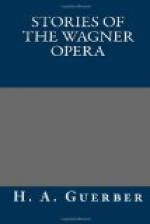’Hail Sachs! Hans Sachs!
Hail Nuremberg’s darling
Sachs!’
[Illustration: The Rhine maidens.]
THE NIBELUNG’S RING.—RHEINGOLD.
It was in 1848, after the completion of Tannhaeuser, that Wagner looked about for a subject for a new opera. Then ’for the last time the conflicting claims of History and Legend presented themselves.’ He had studied the story of Barbarossa, intending to make use of it, but discarded it in favour of the Nibelungen Myths, which he decided to dramatise.[1] His first effort was an alliterative poem entitled ‘The Death of Siegfried,’ which, however, was soon set aside, a part of it only being incorporated in ‘The Twilight [or Dusk] of the Gods.’
Wagner was then dwelling in Dresden, and planning the organisation of a national theatre; but the political troubles of 1849, which resulted in his banishment, soon defeated all these hopes. After a short sojourn in Paris, Wagner took up his abode in Zurich, where he became a naturalised citizen, and where he first turned all his attention to the principal work of his life,—’The Nibelungen Ring.’ In connection with this work Wagner himself wrote: ’When I tried to dramatise the most important moment of the mythos of the Nibelungen in Siegfried’s Tod, I found it necessary to indicate a vast number of antecedent facts, so as to put the main incidents in the proper light. But I could only narrate these subordinate matters, whereas I felt it imperative that they should be embodied in the action. Thus I came to write Siegfried. But here again the same difficulty troubled me. Finally I wrote “Die Walkuere” and “Das Rheingold,” and thus contrived to incorporate all that was needful to make the action tell its own tale.’ The completed poem was privately printed in 1853, and published ‘as a literary product’ ten years later, when the author was in his fiftieth year.
As for the score, it was begun in 1853, and Wagner says: ’During a sleepless night at an inn at Spezzia, the music of “Das Rheingold” occurred to me; straightway I turned homeward and set to work.’ Such was the energy with which he laboured that the complete score of the Rheingold was finished in 1854. Two years later the music to the Walkyrie was all done, and Siegfried begun. But pecuniary difficulties now forced the master to undertake more immediately remunerative work, and, ‘tired of heaping one silent score upon another,’ he undertook and finished ‘Tristan and Ysolde.’ He then thought he would never be able to finish his grand work, and wrote: ’I can hardly expect to find leisure to complete the music, and I have dismissed all hope that I may live to see it performed.’
Fortunately for him, however, Ludwig II. of Bavaria had heard ‘Lohengrin’ when only sixteen, and, a passionate lover of music and art, he had become an enthusiastic admirer of the great composer. One of the very first acts of his reign was, therefore, to despatch his own private secretary to Wagner with the message, ‘Come here and finish your work.’




